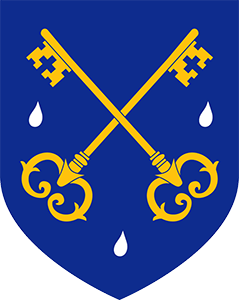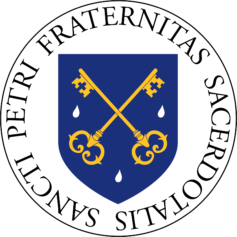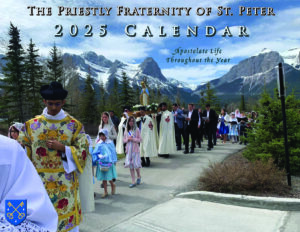Christmas Eve Prime: The Whole World at Peace
by Fr. William Rock, FSSP.
In the early morning of December 24, the Vigil of Christmas, Christmas Eve Day, those in choir hear sung, as part of the Office of Prime, the Christmas Proclamation. After recounting how many years have passed since various historical events, the Proclamation declares that:
| …ab urbe Roma cóndita, anno septingentésimo quinquagésimo secúndo; anno Impérii Octaviáni Augústi quadragésimo secúndo, toto Orbe in pace compósito, sexta mundi ætáte, Iesus Christus, ætérnus Deus æterníque Patris Fílius, mundum volens advéntu suo piíssimo consecráre, de Spíritu Sancto concéptus, novémque post conceptiónem decúrsis ménsibus, in Béthlehem Iudæ náscitur ex María Vírgine factus Homo. (Hic autem in priori voce dicitur, et in tono passionis:) Natívitas Dómini nostri Iesu Christi secúndum carnem. | … in the 752nd year from the foundation of the city of Rome, in the 42nd year of the reign of the Emperor Octavian Augustus, in the 6th age of the world, while the whole world was at peace, Jesus Christ, Himself Eternal God and Son of the Eternal Father, being pleased to hallow the world by His most gracious coming, having been conceived of the Holy Ghost, and when nine months were passed after His conception, was born of the Virgin Mary at Bethlehem of Juda made Man, Our Lord Jesus Christ was born according to the flesh. |
The phrase, “while the whole world was at peace” (“toto Orbe in pace compósito”) is an interesting one and naturally gives rise to the question:
Was the whole world actually at peace?
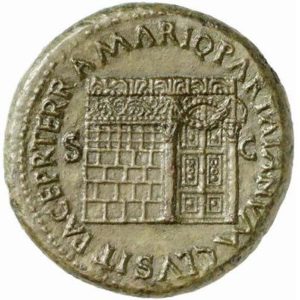
To answer this question, we must look at what peace would have meant to a Roman living at the time, as, after all, Our Lord was born in, more-or-less, a part of Roman Empire.
In the Forum at Rome stood a temple dedicated to the Roman deity Janus. This temple was created by the second King of Rome, Numa Pompilius. Particular to this temple was that it had a set of doors at either end. These “Gates of Janus”, as they were called, were opened when Rome was at war and closed when Rome was at peace.
Plutarch, in his Life of Numa, wrote about this Temple as follows:
There is a temple to him [Janus] in Rome, which has two doors, and which they call the gate of war. It is the custom to open the temple in time of war, and to close it during peace. This scarcely ever took place, as the empire was almost always at war with some state, being by its very greatness continually brought into collision with the neighbouring tribes.
In fact, prior to the rule of Augustus Caesar, the Gates of Janus were only closed twice, once in 700 B.C., during Numa’s reign, and again in 253 B.C., after the First Punic War.
But what was the status of the Gates of Janus during the time of Augustus Caesar, during the time of the birth of Our Lord? In his Res Gestae (sections 2.41-2.45), Augustus tells us the following:
| [Ianum] Quirin[um, quem cl]aussum ess[e maiores nostri voluer]unt, [cum p]er totum i[mperium po]puli Roma[ni terra marique es]set parta vic[toriī]s pax, cum priu[s qua]m nāscerer a condita urbe bis omnino clausum [f]uisse prodātur m[emori]ae, ter me princi[pe senat]us claudendum esse censui[t]. | (The temple of) Janus Quirinus, which our ancestors wished to be closed whenever peace had been obtained, on land and sea, throughout the entire realm of the Roman people, was decreed by the Senate to be closed three times during my time as emperor; even though it is handed down to memory, that before I was born, it had been closed a grand total of two times since the founding of the city. |
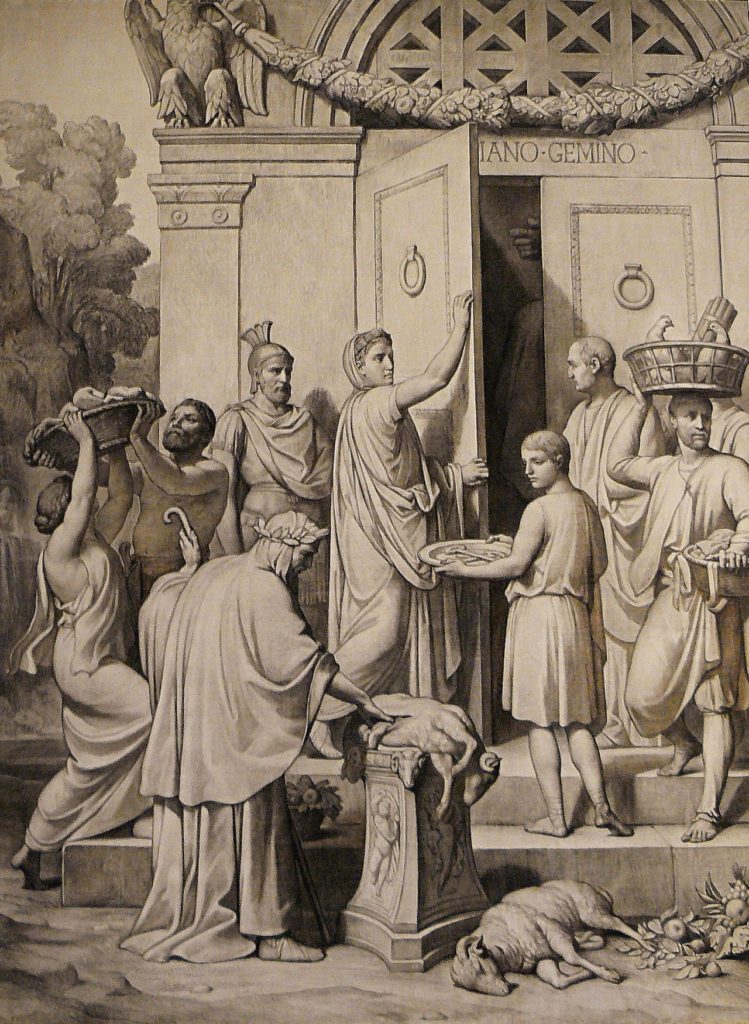
During Augustus’ reign, the Gates of Janus were closed a remarkable three times! From the writings of Cassius Dio, we learn that the Gates were closed in 29 B.C. and 25 B.C. There is some dispute among scholars as to when the third closing of gates occurred, but the Christian Priest Paulus Orosius, a contemporary and companion of St. Augustine and St. Jerome (4th-5th Century A.D.), assigned this third closing to the year of the Birth of Christ (In Paganos 6.22.1, 5):
| Itaque anno ab urbe condita DCCLII Caesar Augustus…Iani portas tertio ipse tunc clausit…Igitur eo tempore, id est eo anno quo firmissimam uerissimamque pacem ordinatione Dei Caesar conposuit, natus est Christus… | And so, in the 752nd year from the foundation of the City of Rome, Caesar Augustus…then himself closed the Gates of Janus for the third time…Therefore at that time – in other words, in that year in which, ordained by God, Caesar arranged the most firm and most true peace – Christ was born… |
It should be noted that Orosius places the birth of Our Lord in the 752nd year since the founding of the City of Rome, which is the same date given in the Christmas Proclamation. Unfortunately, as was indicated above, not all scholars agree with Orosius’s assertion.
But even if Orosius’s assertion that the third closing of the Gates of Janus corresponded with the Birth of Christ is not historically accurate, it is clear that the Roman world was experiencing at that time an unparalleled period of peace. The Gates of Janus had only been closed twice during the 700 some-odd years between the dedication of the Temple of Janus and the reign of Augustus, during which it was closed a remarkable three times.
Having the Gates closed three times within one lifetime would have most assuredly been seen by the people of Rome as indicating a time of unmatched peace, a time when one could safely state, even if there were some military engagements occurring, that “the whole world was at peace.”
Fr. William Rock, FSSP was ordained in the fall of 2019 and is currently Assistant Pastor at Mater Misericordiae parish in Phoenix, AZ. Thanks are due to Mr. Jared Copeland for his assistance on this article.
December 24, 2020
